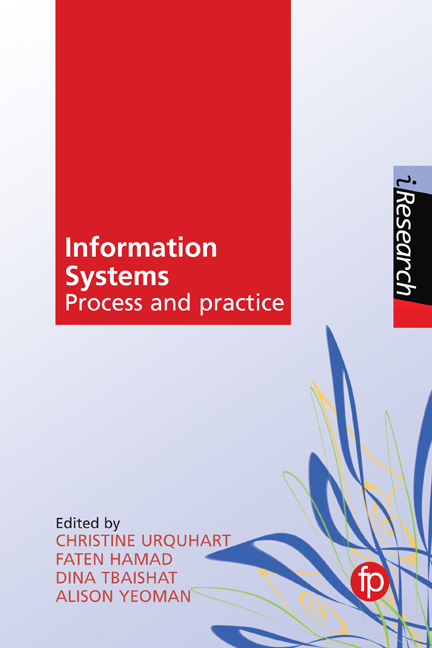Book contents
- Frontmatter
- Contents
- List of tables and figures
- Series editor's foreword
- About the authors
- 1 Introduction
- 2 Approaches to information architecture
- 3 Taxonomy testing for information architecture
- 4 The enterprise website and its information structures
- 5 Analysing activities, roles and processes
- 6 Libraries and the organisation of library processes – a history of operational research, and the use of process modelling
- 7 Using Riva process modelling to study book acquisition in academic libraries
- 8 Workflow analysis and process mapping in US academic libraries
- 9 A theoretical framework for designing and evaluating semi-structured document triage interfaces
- 10 Resource discovery case studies
- 11 Increasing social connection through a community-of-practice-inspired design
- 12 Methods for studying information provision, networking and communication in patient support groups
- 13 Health information systems: clinical data capture and document architecture
- 14 Producing systematic reviews and getting evidence to the clinician
- Index
3 - Taxonomy testing for information architecture
Published online by Cambridge University Press: 08 June 2018
- Frontmatter
- Contents
- List of tables and figures
- Series editor's foreword
- About the authors
- 1 Introduction
- 2 Approaches to information architecture
- 3 Taxonomy testing for information architecture
- 4 The enterprise website and its information structures
- 5 Analysing activities, roles and processes
- 6 Libraries and the organisation of library processes – a history of operational research, and the use of process modelling
- 7 Using Riva process modelling to study book acquisition in academic libraries
- 8 Workflow analysis and process mapping in US academic libraries
- 9 A theoretical framework for designing and evaluating semi-structured document triage interfaces
- 10 Resource discovery case studies
- 11 Increasing social connection through a community-of-practice-inspired design
- 12 Methods for studying information provision, networking and communication in patient support groups
- 13 Health information systems: clinical data capture and document architecture
- 14 Producing systematic reviews and getting evidence to the clinician
- Index
Summary
COMMENTARY: FATEN HAMAD
In this chapter Christine Urquhart considers several methods used for taxonomy testing. She starts by discussing taxonomy development, asserting that the term taxonomy is closely related to classification schemes although, strictly speaking, in information science taxonomies mean the subject domain and how labels in that domain are sorted hierarchically (Blackburn, Smallwood and Earley, 2014). Classification schemes on the other hand are the base for knowledge organisation to place an object in the most appropriate place or class; they are based on taxonomies (also discussed in Chapter 2, ‘Approaches to information architecture’). In other words, taxonomies generally concern the labels for naming contents in a classification scheme in a standardised manner. The author asserts that social, cultural and political differences have a strong effect on the choice of classification and taxonomies; what might be an appropriate taxonomy in one culture might not be appropriate in another one.
Other considerations include the extent of users’ experience, whether they are indexers or end users. For instance, Section 2.5 demonstrated that a person's information-seeking behaviour and their experience and characteristics affect their navigation and use of information space (Schaik and Ling, 2012). Another problem addressed in this chapter is whether the terms are hierarchical or used by association. The most common organisational structure is hierarchical or taxonomical classification. Information architects examine the way different concepts are related to each other within the domain of interest, and group similar content items logically into categories or subject groups. The author emphasises that the hierarchy and associations involved should be tested as well as the taxonomy.
This chapter discusses card sorting methods as useful ways to test taxonomy to ensure usability and accessibility; these often focus on hierarchy testing. The main ones are variations of open and closed card sorting. Case studies (of two academic websites and one database) demonstrate some problems that are associated with website navigation and design; the focus of discussion is the taxonomy testing strategy that authors of each case study employed in their evaluation.
- Type
- Chapter
- Information
- Information SystemsProcess and Practice, pp. 33 - 48Publisher: FacetPrint publication year: 2017



